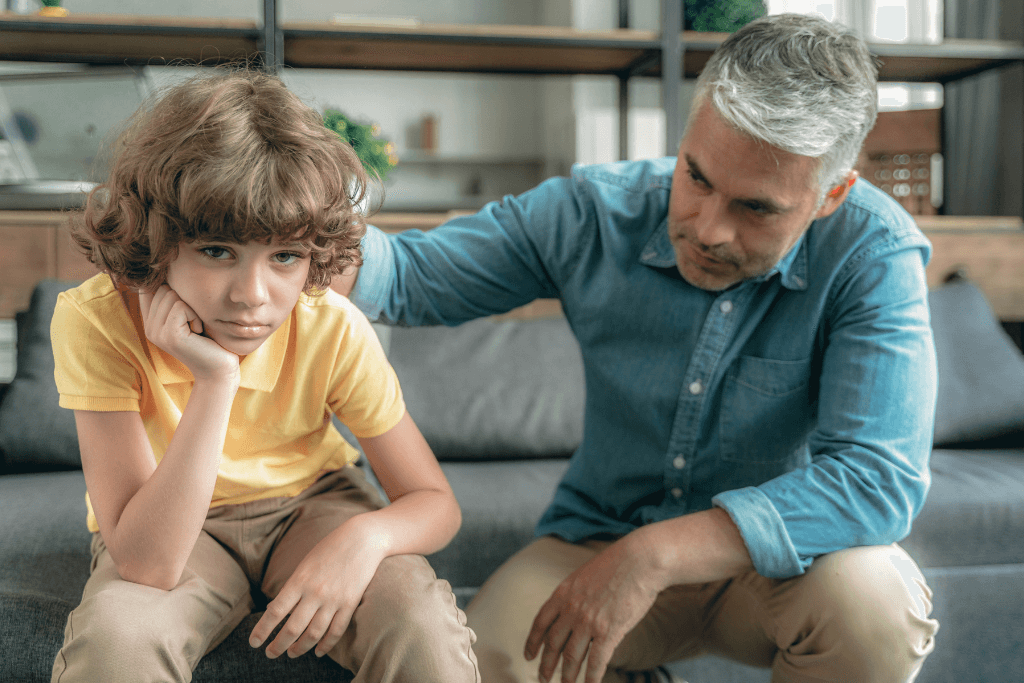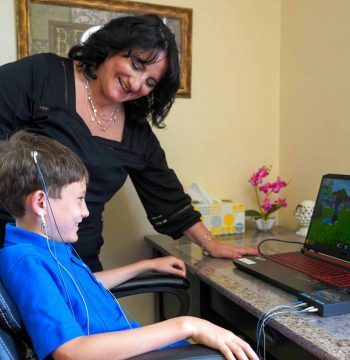Children and teens are not exempt from mental health issues, which affect people of all ages. Sadly, the statistics surrounding children's mental health are particularly alarming. There has been an increase in anxiety, depression, and other mental health disorders among children in recent years and the pandemic only added fuel to the fire.
It is why I started the Global Institute of Children’s Mental Health in January of 2020 because of my concerns about this rise and the lack proper care and natural mental health solutions for children and their families.
Even with the increase in clinical issues in children, many are not receiving the support they need to cope with these challenges, leading to long-term consequences for their well-being. Moreover, parents are struggling to support their children with limited knowledge of what actually fosters behavior and mental health.
Childhood mental health involves reaching emotional and developmental milestones, learning healthy social skills, and coping with problems effectively. According to the CDC, there are specific factors tied to good mental health in children:
- Affection, Resilience, Positivity, Curiosity among children ages 3-5 years
- Curiosity, Persistence and Self-Control among children ages 6-11 years and 12-17 years
Positive mental health and healthy coping skills result in a high quality of life for children and allows them to function well in a variety of settings. Children with mental health disorders experience significant challenges in managing behavior, emotions, and learning abilities, which can affect their daily functioning. That means both at school and home. And when one person in a family is struggling with mental health, so is the whole family.
Children’s Mental Health Statistics
Young and School-Aged Children’s Mental Health Statistics
- Mental, behavioral, or developmental disorders were diagnosed in 17.4% of U.S. children aged 2–8.
- Boys between the ages of 2 and 8 were likelier than girls to have a mental, behavioral, or developmental disorder.
- 3 in 4 children aged 3-17 with depression also had anxiety (73.8%), and almost 1 in 2 had behavior problems (47.2%) in 2016.
- 1 in 3 children aged 3-17 with anxiety also had behavior problems (37.9%), and about 1 in 3 also had depression (32.3%) in 2016.
- 1 in 3 children aged 3-17 with behavior problems also had anxiety (36.6%), and about 1 in 5 also had depression (20.3%) in 2016.
- Nearly 8 in 10 children (78.1%) aged 3-17 with depression received treatment in 2016
- 6 in 10 children aged 3-17 (59.3%) with anxiety received treatment in 2016
- More than 5 in 10 children aged 3-17 (53.5%) with behavior disorders received treatment in 2016
- Children and teens aged 6-17 years old who have ever been diagnosed with anxiety or depression increased from 5.4% in 2003 to 8% in 2007 and to 8.4% in 2011–2012
- In 2016-2019, children aged 6-17 who were discriminated against based on race or ethnicity had higher percentages of one or more physical health conditions (37.8% versus 27.1%) and one or more mental health conditions (28.9% versus 17.8%).
Adolescent’s Mental Health Statistics
- 15.1% of adolescents aged 12-17 had a major depressive episode
- 36.7% of adolescents aged 12-17 had persistent sadness or hopelessness.
- 4.1% of adolescents aged 12-17 had a substance use disorder.
- 1.6% of adolescents aged 12-17 had an alcohol use disorder.
- 3.2% of adolescents aged 12-17 had an illicit drug use disorder.
- 18.8% of adolescents aged 12-17 seriously considered attempting suicide.
- 15.7% of adolescents aged 12-17 made a suicide plan.
- 8.9% of adolescents aged 12-17 attempted suicide.
- 2.5% of adolescents aged 12-17 made a suicide attempt requiring medical treatment.2
- More than 1 in 5 (22%) children living below 100% of the federal poverty level have a mental, behavioral, or developmental disorder.
- Being diagnosed with anxiety increased from 5.5% in 2007 to 6.4% in 2011-2012.
- Being diagnosed with depression did not change between 2007 (4.7%) and 2011-2012 (4.9%).
Source: https://www.cdc.gov/childrensmentalhealth/data.html
- Anxiety disorders affect 3.6% of 10-14-year-olds and 4.6% of 15-19-year-olds.
- Adolescent depression affects 1.1% of those between the ages of 10-14 and 2.8% of those between the ages of 15-19.
- ADHD occurs in 3.1% of children aged 10-14 and 2.4% of those aged 15-19
- Conduct disorders appear in 36% of 10-14-year-olds and 24% of 15-19-year-olds
Teen and College Students Mental Health Statistics
Source: https://www.who.int/news-room/fact-sheets/detail/adolescent-mental-health
- In the past year, 15.08 percent of teenagers (ages 12-17) have had a major depressive episode.
- Approximately 10.6% of teenagers (over 2.5 million) suffer from severe major depression.
- 4.08% of U.S. youth reported having substance use disorders.
- Alcohol consumption disorder affected 1.64% of teens, and illicit drug usage disorder affected 3.16%.
- Only 27.2% of teens with severe depression receive consistent treatment (7-25 sessions per year) in the U.S.
- Suicide ranks fourth among the leading causes of death in the 15-19 age group.
- Only 0.759% of students are diagnosed with an Emotional Disturbance (ED) for an Individualized Education Program (IEP).
Source: https://www.mhanational.org/issues/2022/mental-health-america-youth-data
- Anxiety and depression are significant problems for seven out of ten teens in the United States (ages between 13 and 17 years old).
- 75% of American high school students expressed anger, sadness, stress, fear, and boredom.
- The average stress level among American teens was 5.8 on a 10-point scale, whereas typical values for adults are 3.8.
- Suicidal thoughts and suicide-related outcomes increased by 47% among American students between 2008 and 2017 (from 7.0% to 10.3%).
- The top three concerns of U.S. college students are anxiety, depression, and stress, according to 54.2% of the survey of mental health professionals.
- 80% of U.S. students report being stressed at some point or another, and 34% report feeling depressed, as per the Anxiety and Depression Association of America
Source: https://research.com/education/student-stress-statistics
Is Mental Health in Children in the US on the Rise?
Yes. Trauma, social media, and academic pressure all contribute to children’s mental health issues. From 2016 to 2019, there was an increase in emergency department (ED) visits with a principal diagnosis related to mental health for ages 0-17 years, from 784.1 per 100,000 population to 869.3. The rate further increased to 976.8 per 100,000 population in 2018, though it declined slightly in 2019.
This rate declined slightly in 2019. However, in 2018, the rate was 976.8 per 100,000 population, a 25% increase from 2016.
And the social isolation and disruption in their education only served to increase issues during the pandemic.
What Percentage of Children have Mental Health Issues?
Mental health issues affect children in the US with varying degrees of severity. According to a report from 2022, roughly 20% of American children and adolescents suffer from mental, emotional, developmental, or behavioral disorders (Child and Adolescent Mental Health, 2022).
According to recent statistics, approximately 1 in 6 children between the ages of 6 and 17 in the United States have a mental health disorder, with anxiety and depression being the most common.
Additionally, research indicates that mental health concerns are not limited to older children and adolescents. Approximately 1 in 7 children aged 2 to 8 in the United States have a mental, behavioral, or developmental disorder, highlighting the importance of early detection and intervention.
It is crucial to recognize the prevalence of mental health issues among children and take proactive steps to address and manage them effectively.
How Many Kids in the US Suffer from Mental Health?
Mental health issues among children in the United States are a growing concern. US children and youth suffer from some of the highest rates of mental health disorders in the world, including evidence that even very young children are affected. Approximately 20% of children have an identified mental health condition, and 40% will meet criteria for mental illness by the age of 18 (Shim et al., 2022).
These disorders can range from anxiety and depression, ADHD to more severe conditions like bipolar disorder and schizophrenia. The prevalence of mental health issues in children is a significant public health challenge, with potentially long-lasting consequences for their future well-being.
It is essential to prioritize the mental health needs of children and provide them with the necessary tools and resources to cope with their conditions and achieve optimal health outcomes.
How Many Teens Have a Mental Health Issue in the US?
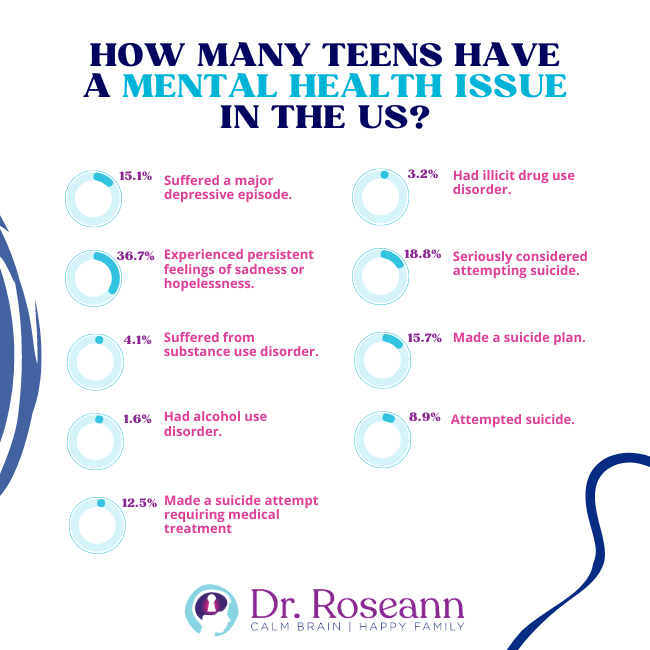
The following outcomes were reported among adolescents aged 12-17 years in 2018-2019:
- 15.1% suffered a major depressive episode.
- 36.7% experienced persistent feelings of sadness or hopelessness.
- 4.1% suffered from substance use disorder.
- 1.6% had alcohol use disorder.
- 3.2% had illicit drug use disorder.
- 18.8% seriously considered attempting suicide.
- 15.7% made a suicide plan.
- 8.9% attempted suicide.
- 2.5% made a suicide attempt requiring medical treatment
What are the Most Common Mental Health Issues in Children?
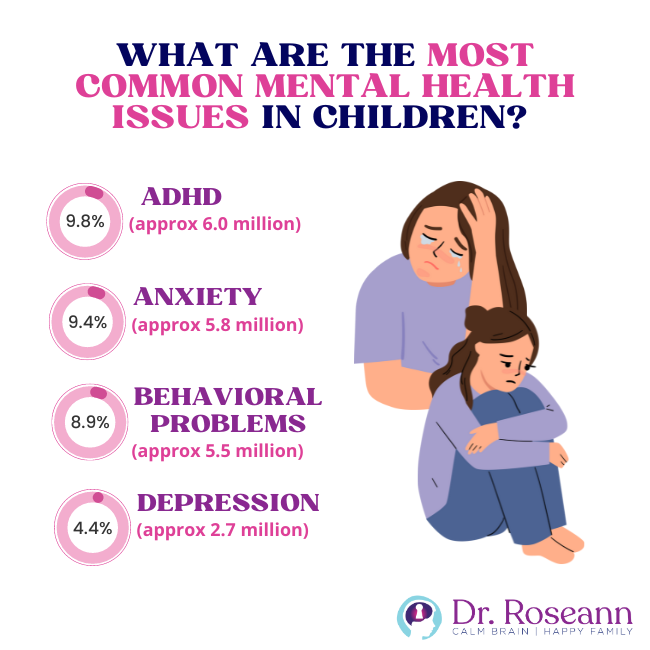
- ADHD 9.8% (approx 6.0 million)
- Anxiety 9.4% (approx 5.8 million)
- Behavior problems 8.9% (approx 5.5 million)
- Depression 4.4% (approx 2.7 million)
How Many Children in the US are on Psychiatric Medications?
The use of psychiatric medications among children in the United States has been steadily increasing in recent years. Current statistics indicate that the use of psychiatric medications among children in the United States has continued to increase since 2012.
According to a study published in the Journal of Child and Adolescent Psychopharmacology in 2020 (Zito et. al), the prevalence of psychiatric medication use among children aged 6 to 17 increased from 7.4% in 2011-2012 to 9.4% in 2015-2016.
The most commonly prescribed medications were ADHD medications, antidepressants, and antipsychotics.
CDC (2020) data also show that treatment rates vary among mental disorders.
In 2016, the following percentages were found among children aged 3-17:
- The number of children treated for depression was nearly 8 in 10 (78.1%).
- 6 out of 10 children (59.3%) with anxiety received treatment.
- More than 5 out of 10 children with behavior disorders (53.5%) received treatment.
We need to be concerned about the overuse of psychiatric medications such as SSRI’s and ADHD medication not just because they are very dangerous in a developing brain but because their use sends the message that changing behaviors isn’t as important or powerful.
Parents need to know that they have an incredible amount of power in shaping desired behaviors and healthy coping skills with the right methods.
What are the Global Statistics on Mental Health in Children?
Mental health issues among children are a global concern, with significant impacts on their overall well-being and development. According to the World Health Organization (WHO), approximately 10-20% of children and adolescents worldwide experience mental disorders. These disorders can range from anxiety and depression to more severe conditions like bipolar disorder and schizophrenia.
A mental disorder affects 1 in 7 adolescents aged 10 – to 19-year-olds globally, accounting for 13% of disease burden (World Health Organization, 2021). Approximately, 166 million adolescents (89 million boys and 77 million girls) are estimated to be in this category.
In our BrainBehaviorReset™ Program, we support families remotely all over the world, and during the pandemic crisis level, our clients experienced clinical mental health issues regardless of where they were located. I also saw an increase in the use of psychiatric medication with children and teens that I was working with outside of the US.
Is There a Growing Children’s Mental Health Crisis?
Yes. Research indicates that mental health issues among children have been on the rise in recent years, with many factors contributing to this trend.
From 2008 to 2020, suicide deaths among people 12 and over increased 16% overall, from 14.0 per 100,000 pupulation to 16.3. For teenagers ages 12-17, suicide deaths increased from 3.7 to 6.3.
Children of color, adolescents, young children, and LGBTQ youth were particularly vulnerable to the negative consequences of mental health conditions during the pandemic. More than 25% of high school students reported worsening emotional and cognitive health, and more than 20% of parents reported their children's mental or emotional health to be worsened during the said period.
A survey of LGBTQ youth (ages 13-17) found that 73% reported anxiety symptoms during the pandemic, 67% had depression, and 48% had serious thoughts of suicide. Although data on children of color are limited, research suggests that they have higher rates of mental illness, but are less likely to receive treatment.
Is There a Rise in Children’s Mental Health Issues During COVID?
Yes. The COVID-19 pandemic has further exacerbated the mental health crisis among children. A recent Morbidity and Mortality Weekly Report (MMWR) published by the Centers for Disease Control and Prevention highlights the concerning prevalence of mental health disorders among American children. According to the report, these issues existed even before COVID-19 (Shim et al., 2022).
Studies suggest that the pandemic has led to increased rates of anxiety, depression, and social isolation among children, further highlighting the urgent need for mental health resources and support.
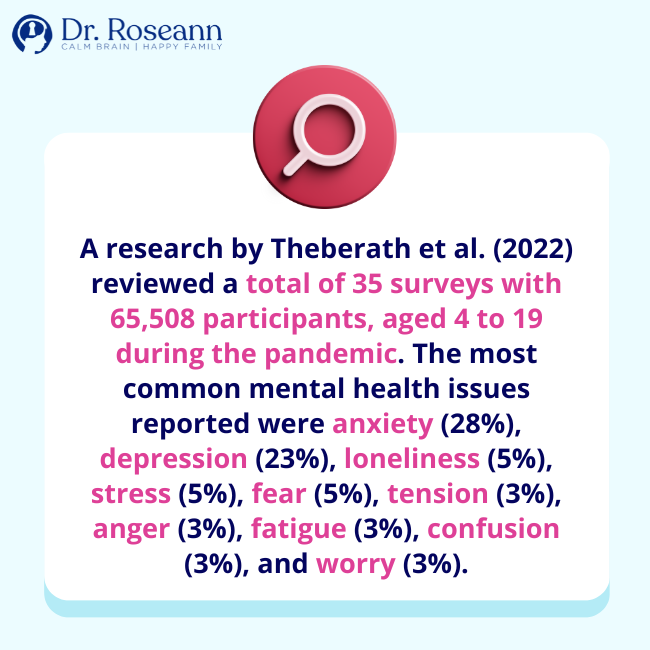
A research by Theberath et al. (2022) reviewed a total of 35 surveys with 65,508 participants, aged 4 to 19 during the pandemic. The most common mental health issues reported were anxiety (28%), depression (23%), loneliness (5%), stress (5%), fear (5%), tension (3%), anger (3%), fatigue (3%), confusion (3%), and worry (3%).
COVID-19 had a significant impact on mental health in children and adolescents with psychiatric and/or developmental disorders, including severe obesity, chronic lung disease, ADHD, cystic fibrosis, and obsessive-compulsive disorders.
I have never witnessed more children and adolescents seek first time mental health treatment as I have during the pandemic. The long-term effects of social isolation are unknown but I continue to see its impact at our Ridgefield, CT center.
Why is Children’s Mental Health an Issue?
There are many factors contributing to this trend, including increased academic pressure, social media use, and exposure to traumatic events. Furthermore, many children and adolescents with mental health conditions do not receive the necessary care and support, highlighting the urgent need for improved access to mental health resources.
Mental health of children has a significant impact on their development and well-being. Children's mental health issues can have long-term effects on their functioning and quality of life as adults if they are not treated. Kids with mental health issues are likely to suffer from:
- Increased stress
- Academic pressure
- Poor food quality
- Poor nutrition
- Increased genetic mutation
- Over reliance on psychiatric medications
- Over parenting
- Low stress tolerance
Many of the children I work with just feel so overwhelmed. I think it is safe to say that their parents feel very much the same way. That is why in our BrainBehaviorReset™ Program we offer wrap-around support to the child and their parents. We have to peel back the layers to get to the root issues and with so many factors affecting mental health, every case needs a multi-pronged approach.
Children's mental health is critical to their overall well-being and future success, so identifying and addressing mental health issues as early as possible is crucial. That is why it is never too early to address a problem. So many parents are filled with regret when they get to me and that doesn't have to be the case! Prioritizing child and family mental health is key!
Are American Children Being Over Diagnosed with Mental Health Conditions?
No. According to Merten et al. (2017), although there are factors that could affect overdiagnosis, the evidence base is insufficient to draw definite conclusions about the extent of overdiagnosis in children and adolescents. They also also found that, despite the fact that the literature search identified few studies specifically looking at overdiagnosis, many suggest misdiagnosis does occur.
The larger concern is misdiagnosis and overuse of medication. Some healthcare providers may rely too heavily on medication as a treatment option, rather than exploring non-pharmacological interventions like therapy and behavioral interventions.
Again it is important to note that even with such increases in clinical issues, kids and their families aren’t getting help or the right interventions. I see that families are searching for expert care and are unable to find it. That is why we need to get simple science-backed solutions into the hands of parents.
Accessing Mental Health Support
The Mental Health America Youth Data 2022 indicates that 60.3% of youth with major depression episodes do not receive mental health treatment. For instance, many teens with a major depressive episode remain untreated.
1 in 3 teens still failed to receive mental health services, even in states with the greatest access for youth. Untreated depression in teenagers varies from 30.0% in Maine to 73.1% in Texas.
The prevalence of children without mental health coverage varies from 1.9% in Massachusetts to 17.7% in Arkansas. In Arizona, Idaho, and Nevada, mental illness is more prevalent and treatment is less accessible.
In spite of the enactment of the Mental Health Parity and Addiction Equity Act (MHPAE) in 2008, which guarantees equal coverage of mental health and substance use services, the number of children with private insurance that does not cover mental or emotional problems increased by 0.3% from last year. As a result, 950,000 teens do not have behavioral health coverage.
As a parent, it's essential to know how to access mental health support for your child if they are experiencing mental health issues. You can start by learning about the symptoms or clinical issues your child has and how it affects the brain and behavior.
Next, reach out to your child's primary care provider, school counselor, or a mental health specialist to get behavioral and parenting support. Early detection and intervention are crucial to prevent conditions from worsening and affecting your child's overall well-being and development.
Explore science-backed natural solutions for mental health. Supplements such as magnesium, cognitive-behavioral or exposure and response prevention therapy, and other ways to calm the brain are essential in supporting mental wellness.
You can play a crucial role in supporting your child by creating a supportive and open environment at home, reinforcing healthy coping skills, and getting the right care and resources in place. Remember, you are the CEO of your child’s mental health and with the right parenting tools, you can help your child thrive.
If you need help finding the right solution for your child or teen with behavioral or mental health struggles, then take our solution matcher to give your next steps.
Citations
Centers for Disease Control and Prevention. (2022, June 3). Data and Statistics on Children’s Mental Health. Centers for Disease Control and Prevention; CDC. https://www.cdc.gov/childrensmentalhealth/data.html
Child and Adolescent Mental Health. (2022). In www.ncbi.nlm.nih.gov. Agency for Healthcare Research and Quality (US). https://www.ncbi.nlm.nih.gov/books/NBK587174/
Merten, E. C., Cwik, J. C., Margraf, J., & Schneider, S. (2017). Overdiagnosis of mental disorders in children and adolescents (in developed countries). Child and Adolescent Psychiatry and Mental Health, 11(1). https://doi.org/10.1186/s13034-016-0140-5
Shim, R., Szilagyi, M., & Perrin, J. M. (2022). Epidemic Rates of Child and Adolescent Mental Health Disorders Require an Urgent Response. Pediatrics, 149(5). https://doi.org/10.1542/peds.2022-056611
Theberath, M., Bauer, D., Chen, W., Salinas, M., Mohabbat, A. B., Yang, J., Chon, T. Y., Bauer, B. A., & Wahner-Roedler, D. L. (2022). Effects of COVID-19 pandemic on mental health of children and adolescents: A systematic review of survey studies. SAGE Open Medicine, 10, 205031212210867. https://doi.org/10.1177/20503121221086712
World Health Organization. (2021, November 17). Adolescent Mental Health. World Health Organization; World Health Organization. https://www.who.int/news-room/fact-sheets/detail/adolescent-mental-health
Youth data 2022. (2022). Mental Health America. https://www.mhanational.org/issues/2022/mental-health-america-youth-data
Zito, J. M., Safer, D. J., dosReis, S., Gardner, J. F., Magder, L., Soeken, K., & Ross, M. (2020). Trends in the prescribing of psychotropic medications to preschoolers. Journal of Child and Adolescent Psychopharmacology, 30(2), 95-102. doi: 10.1089/cap.2019.0086
Always remember… “Calm Brain, Happy Family™”
Are you looking for SOLUTIONS for your struggling child or teen?
Dr. Roseann and her team are all about solutions, so you are in the right place!
There are 3 ways to work with Dr. Roseann:
You can get her books for parents and professionals, including: It’s Gonna Be OK™: Proven Ways to Improve Your Child’s Mental Health, Teletherapy Toolkit™ and Brain Under Attack: A Resource For Parents and Caregivers of Children With PANS, PANDAS, and Autoimmune Encephalopathy.
If you are a business or organization that needs proactive guidance to support employee mental health or an organization looking for a brand representative, check out Dr. Roseann’s media page and professional speaking page to see how we can work together.
Dr. Roseann is a Children’s Mental Health Expert and Therapist who has been featured in/on hundreds of media outlets including, CBS, NBC, FOX News, PIX11 NYC, The New York Times, The Washington Post,, Business Insider, USA Today, CNET, Marth Stewart, and PARENTS. FORBES called her, “A thought leader in children’s mental health.”

She is the founder and director of The Global Institute of Children’s Mental Health and Dr. Roseann Capanna-Hodge. Dr. Roseann is a Board Certified Neurofeedback (BCN) Practitioner, a Board Member of the Northeast Region Biofeedback Society (NRBS), Certified Integrative Medicine Mental Health Provider (CMHIMP) and an Amen Clinic Certified Brain Health Coach. She is also a member of The International Lyme Disease and Associated Disease Society (ILADS), The American Psychological Association (APA), Anxiety and Depression Association of America (ADAA) National Association of School Psychologists (NASP), International OCD Foundation (IOCDF) International Society for Neurofeedback and Research (ISNR) and The Association of Applied Psychophysiology and Biofeedback (AAPB).
© Roseann-Capanna-Hodge, LLC 2023
Disclaimer: This article is not intended to give health advice and it is recommended to consult with a physician before beginning any new wellness regime. *The effectiveness of diagnosis and treatment vary by patient and condition. Dr. Roseann Capanna-Hodge, LLC does not guarantee certain results.

